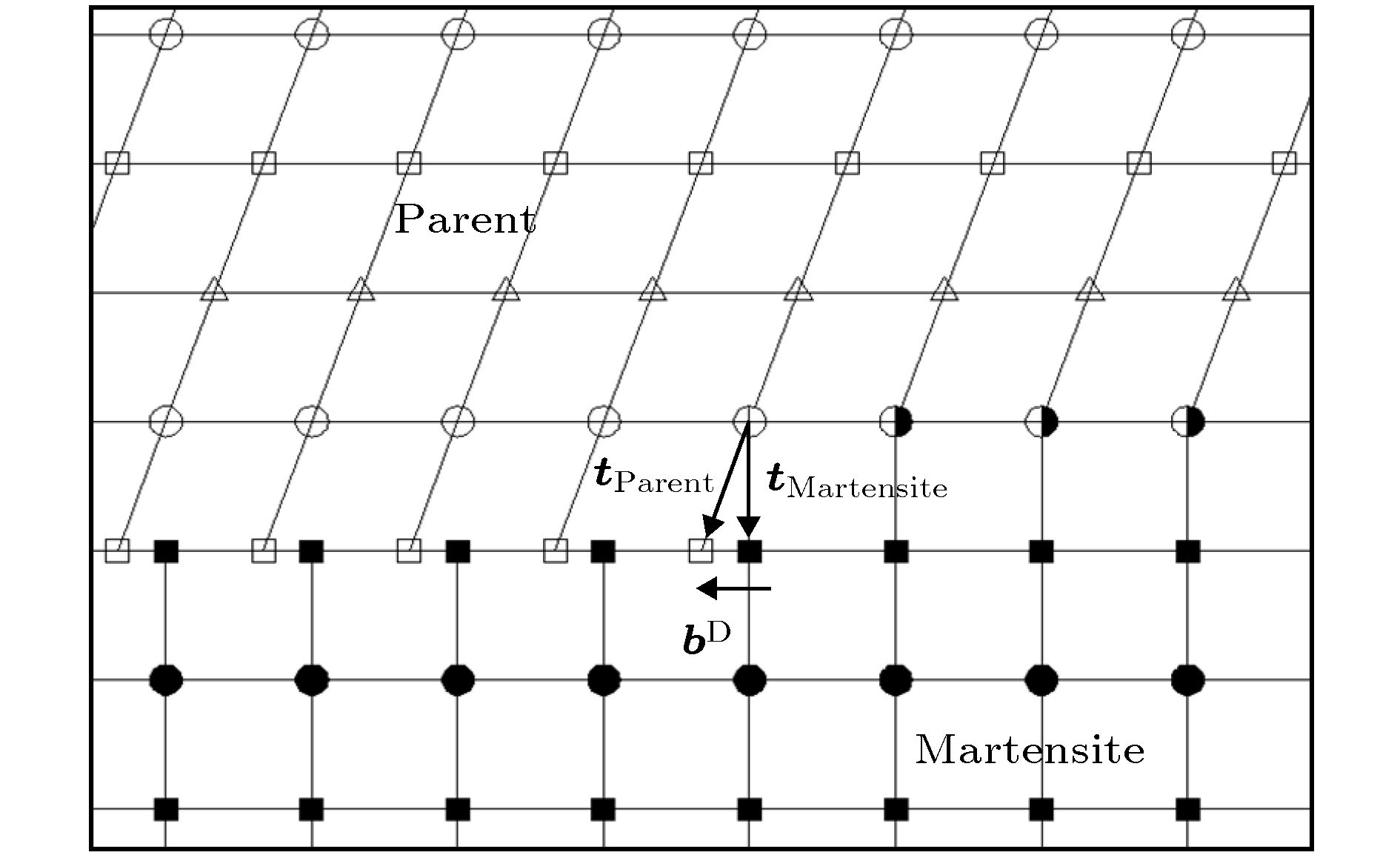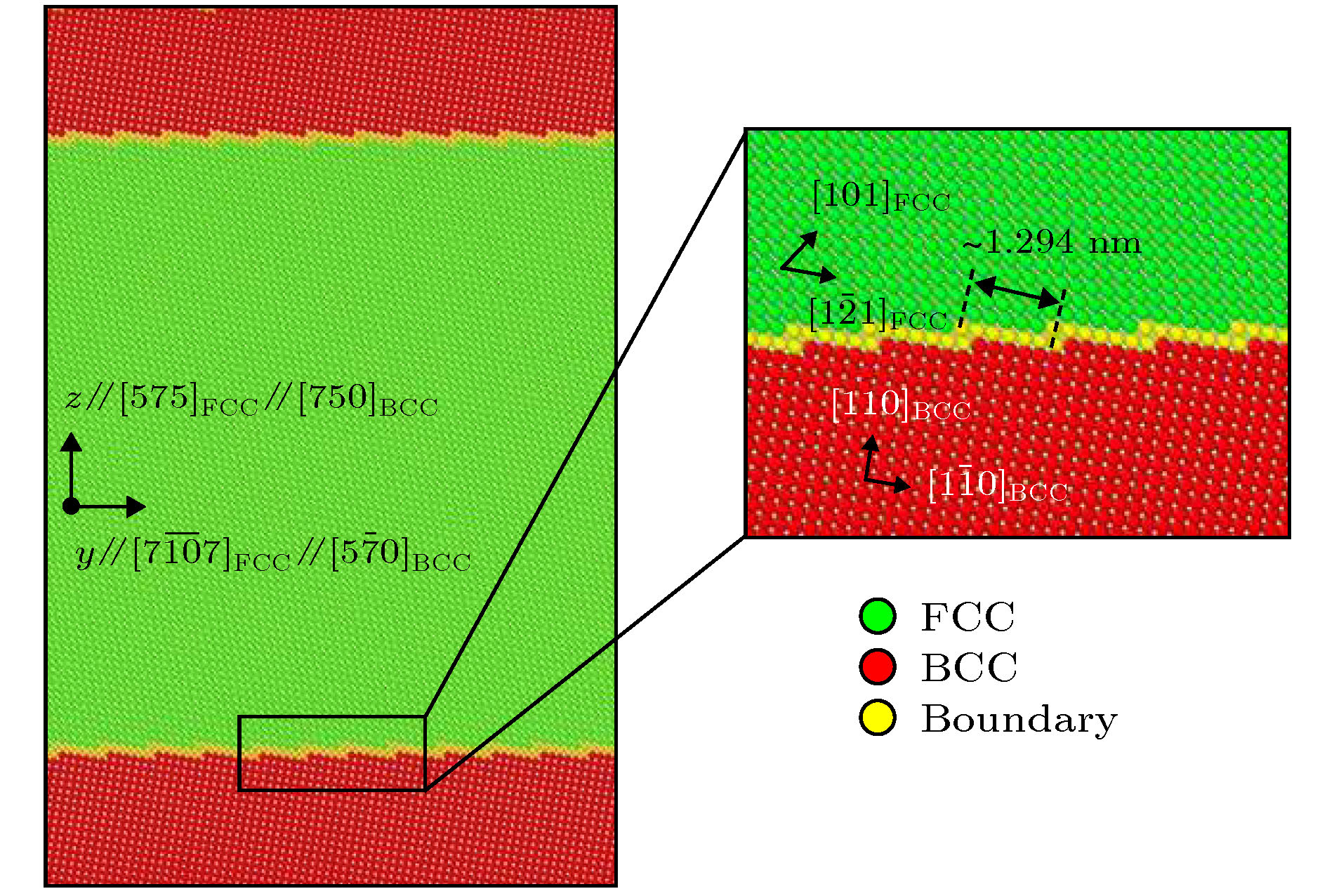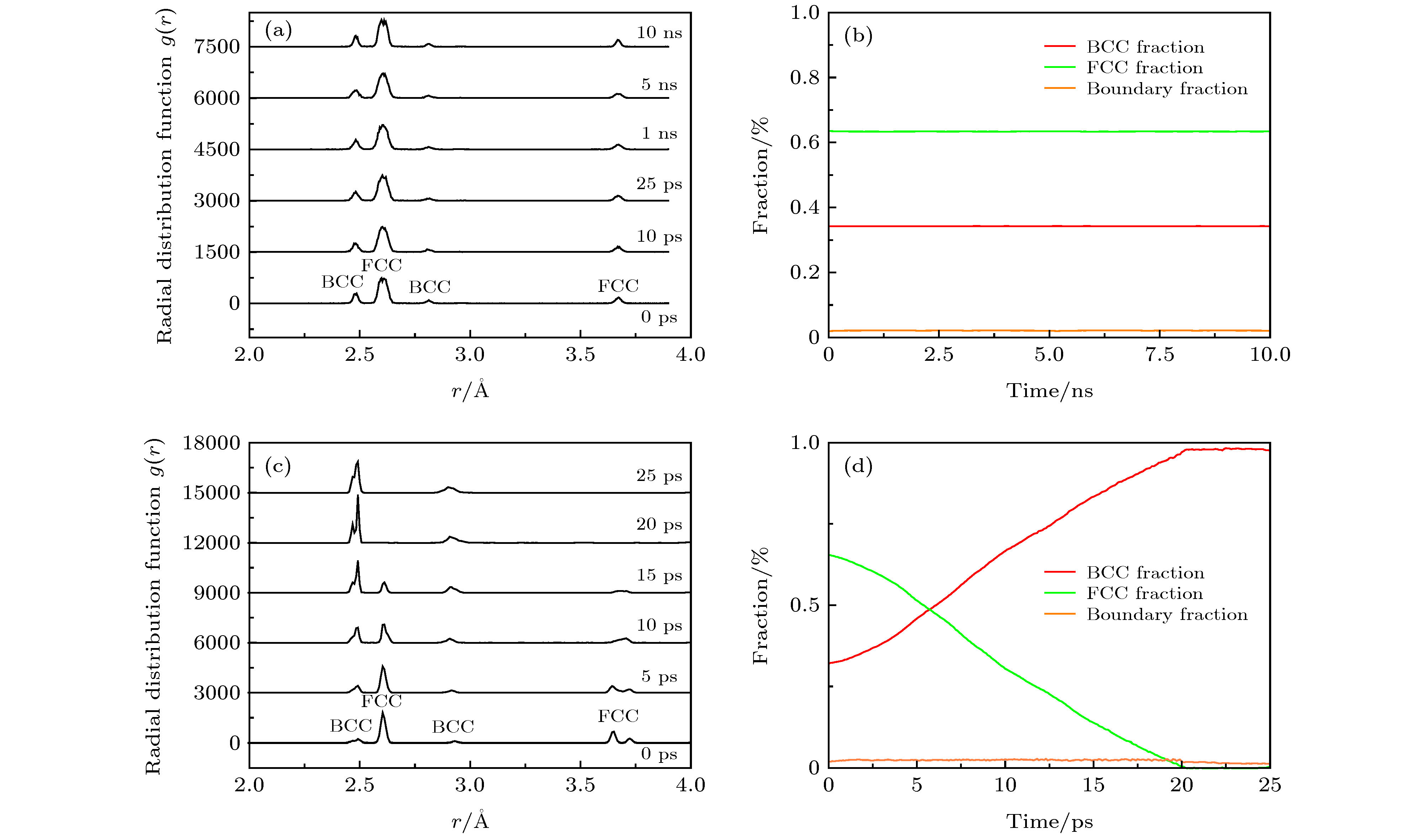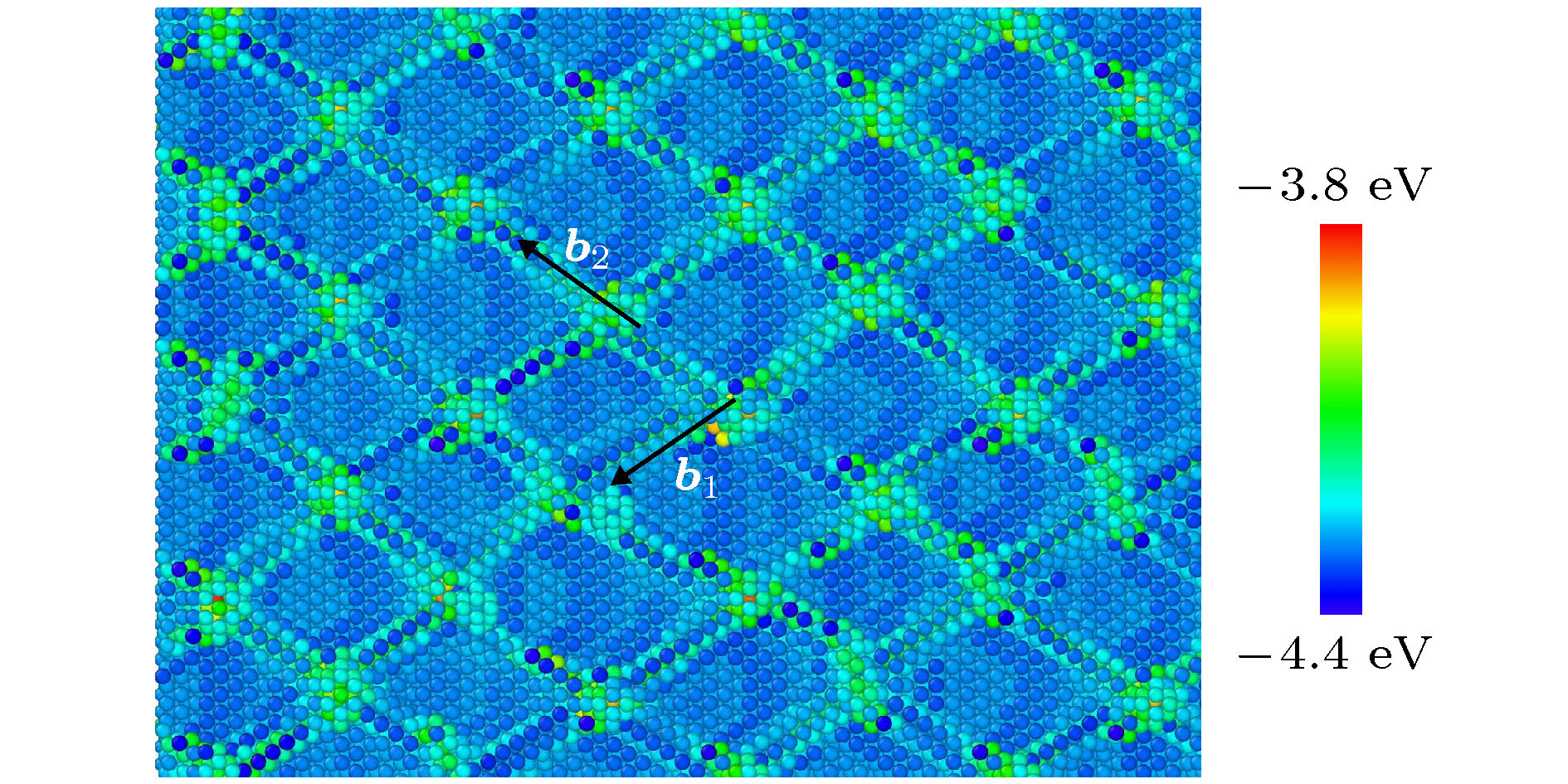-
The martensitic transformation between the high-temperature face-centered cubic (FCC) phase and the low-temperature body-centered cubic (BCC) phase in iron-based alloys has been studied for years, which plays a critical role in controlling microstructures and hence properties of the alloys. Generally, the BCC structure martensitic phase forms from the FCC parent phase, involving a collective motions of atoms over a distance less than the interatomic distance in the vicinity of the interphase boundary. Thus the structure of interphase boundary separating the FCC and BCC phases is the key characteristics to quantitatively understanding the mechanism and kinetics of martensitic transformation. Due to the difficulty in observing the atomic motions taking place at a velocity as high as the speed of sound, the experimental investigation on the migration of FCC/BCC interphase boundary during the transformation is as yet limited. Noteworthily, molecular dynamics (MD) simulation has been applied to studying the martensitic transformation, in particular for investigating the mobility of the FCC/BCC interphase boundary in iron. However, in most of the MD studies the atomistically planar interfaces of {111}FCC // {110}BCC are considered as the initial configuration of the interphase boundary between FCC and BCC phases, which is in contradiction to the high-resolution TEM observations. In fact, the FCC/BCC interphase boundary, which is known as the macroscopic habit plane, is a semi-coherent interface consisting of several steps and terrace planes on an atomic scale. In the present work, the atomic configuration of a terrace-step FCC/BCC interphase boundary of iron is built in terms of the topological model. The MD simulation is conducted to clarify the mechanism of interphase boundary migration in the FCC-to-BCC transformation. The results show that the FCC/BCC boundary migrates along its normal at the expense of FCC phase as a result of the lateral motions of the transformation dislocations. Meanwhile, the interphase boundary maintains the stable terrace-step structure during the transformation. Further examinations reveal that the transformation dislocations move steadily at a velocity as high as (2.8 ± 0.2) × 103 m/s, affecting the migration of the interphase boundary with a constant velocity of about (4.4 ± 0.3) × 102 m/s. The effective migration velocity of FCC/BCC interface exhibits dynamic properties consistent with the characteristic features commonly observed in a displacive martensitic transformation. Additionally, the motion of transformation dislocations gives rise to the macroscopic shape strain composed of a shear component
$ {\varGamma _{{\rm{yz}}}} = 0.349$ parallel to the boundary and a dilatation$ {\varGamma _{{\rm{zz}}}} = 0.053$ normal to the boundary in the MD simulation, which is close to the crystallographic calculations by the topological model.-
Keywords:
- transformation dislocation /
- interphase boundary migration /
- molecular dynamics simulation /
- topological model of martensitic transformation
[1] Porter D A, Easterling K E 1992 Phase Transformations in Metals and Alloys (2nd Ed.) (London: Chapman and Hall) p1
[2] 徐祖耀 1999 马氏体相变与马氏体(北京: 科学出版社) 第1页
Xu Z Y 1999 Martensitic Transformation and Martensite (Beijing: Science Press) p1 (in Chinese)
[3] Christian J W 2002 The Theory of Transformation in Metal and Alloys (Amsterdam: Elsevier) p1
[4] Honeycombe R W K, Bhadeshia H K D H 2006 Steels: Microstructure and Properties (3rd Ed.) (Amsterdam: Elsevier) p1
[5] Shibata A, Murakami T, Morito S, Furuhara T, Maki T 2008 Mater. Trans. 49 1242
 Google Scholar
Google Scholar
[6] Maki T 2012 Phase Transformation in Steels (Cambridge: Woodhead Publishing) p34
[7] Wayman C M 1964 Introduction to the Crystallography of Martensitic Transformations (New York: MacMillan) p1
[8] Moritani T, Miyajima N, Furuhara T, Maki T 2002 Scr. Mater. 47 193
 Google Scholar
Google Scholar
[9] Ogawa K, Kajiwara S 2004 Philos. Mag. 84 2919
 Google Scholar
Google Scholar
[10] Hirth J P 1994 J. Phys. Chem. Solids 55 985
 Google Scholar
Google Scholar
[11] Hirth J P, Pond R C 1996 Acta Mater. 44 4749
 Google Scholar
Google Scholar
[12] Pond R C, Celotto S, Hirth J P 2003 Acta Mater. 51 5385
 Google Scholar
Google Scholar
[13] Pond R C, Ma X, Chai Y W, Hirth J P 2007 Dislocation in Solids (Amsterdam: Elsevier) p225
[14] Ma X, Pond R C 2008 Mater. Sci. Eng. A481-482 404
[15] Wei Z Z, Ma X, Zhang X P 2014 Philos. Mag. Lett. 94 288
 Google Scholar
Google Scholar
[16] Ma X, Wei Z Z, Zhang X P 2014 J. Mater. Sci. 49 4648
 Google Scholar
Google Scholar
[17] 韦昭召, 马骁, 张新平 2018 金属学报 54 1461
 Google Scholar
Google Scholar
Wei Z Z, Ma X, Zhang X P 2018 Acta Metall. Sin. 54 1461
 Google Scholar
Google Scholar
[18] Mohammed A, Sehitoglu H 2020 Acta Mater. 183 93
 Google Scholar
Google Scholar
[19] Bos C, Sietsma J, Thijsse B 2006 Phys. Rev. B 73 104117
 Google Scholar
Google Scholar
[20] Suiker A S J, Thijsse B J 2013 J. Mech. Phys. Solids 61 2273
 Google Scholar
Google Scholar
[21] Wang B J, Urbassek H M 2013 Phys. Rev. B 87 104108
 Google Scholar
Google Scholar
[22] Wang B J, Urbassek H M 2014 Comput. Mater. Sci. 81 170
 Google Scholar
Google Scholar
[23] Tateyama S, Shibuta Y, Suzuki T 2008 Scr. Mater. 59 971
 Google Scholar
Google Scholar
[24] Tateyama S, Shibuta Y, Kumagai T, Suzuki T 2011 ISIJ Int. 51 1710
 Google Scholar
Google Scholar
[25] Ou X, Sietsma J, Santofimia M J 2016 Modell. Simul. Mater. Sci. Eng. 24 055019
 Google Scholar
Google Scholar
[26] Song H, Hoyt J J 2012 Acta Mater. 60 4328
 Google Scholar
Google Scholar
[27] Maresca F, Curtin W A 2017 Acta Mater. 134 302
 Google Scholar
Google Scholar
[28] Engin C, Sandoval L, Urbassek H M 2008 Modell. Simul. Mater. Sci. Eng. 16 035005
 Google Scholar
Google Scholar
[29] Finnis M W, Sinclair J E 1984 Philos. Mag. A 50 45
 Google Scholar
Google Scholar
[30] Plimpton S 1995 J. Comput. Phys. 117 1
 Google Scholar
Google Scholar
[31] Stukowski A 2009 Modell. Simul. Mater. Sci. Eng. 18 015012
[32] Faken D, Jonsson H 1994 Comput. Mater. Sci. 2 279
 Google Scholar
Google Scholar
[33] Shimizu F, Ogata S, Li J 2007 Mater. Trans. 48 2923
 Google Scholar
Google Scholar
[34] Chiao Y H, Chen I W 1990 Acta Metall. Mater. 38 1163
 Google Scholar
Google Scholar
[35] Hirth J P, Lothe J 1982 Theory of Dislocations (New York: McGraw-Hill) p1
[36] Hirth J P, Mitchell J N, Schwartz D S, Mitchell T E 2006 Acta Mater. 54 1917
 Google Scholar
Google Scholar
[37] Chai Y W, Kim H Y, Hosoda H, Miyazaki S 2008 Acta Mater. 56 3088
 Google Scholar
Google Scholar
[38] Yu Z Z, Clapp P C 1989 Metall. Trans. A 20 1617
 Google Scholar
Google Scholar
[39] Meyer R, Entel P 1998 Phys. Rev. B 57 5140
 Google Scholar
Google Scholar
-
图 5 非共格FCC-BCC复相体系在0−10 ns内的径向分布函数图 (a)及各相原子比例分数随相变时间变化关系曲线(b); 约束共格FCC-BCC复相体系在0−25 ps内的径向分布函数图(c) 及各相原子比例分数随相变时间变化关系曲线(d)
Figure 5. RDF of the FCC-BCC system with (a) incoherent and (c) constraint coherent boundary; and evolution of the phase fractions with (b) incoherent and (d) constraint coherent boundary.
图 8
${(111)_{{\rm{FCC}}}}$ //${(110)_{{\rm{BCC}}}}$ 非台阶型相界面迁移及两相晶体结构演变过程模拟结果 (a) 0 ps; (b) 15 ps; (c) 30 psFigure 8. Snapshots of the evolution of the local structure and propagation of the
${(111)_{{\rm{FCC}}}}$ //${(110)_{{\rm{BCC}}}}$ boundary at different times: (a) 0 ps; (b) 15 ps; (c) 30 ps (in which the atoms are colored by their coordinate number where green: FCC, red: BCC and yellow: phase boundary).图 10 约束共格FCC/BCC相界面在 (a) 10.0 ps和 (b) 10.2 ps时的微观结构以及相界面近邻原子位移状态图(c)
Figure 10. Configuration of the step-like constraint coherent interface between FCC and BCC crystals at (a) 10.0 ps and (b) 10.2 ps evaluated by common neighbor analysis method; and (c) the atomic displacements near the transforming boundary.
表 1 FCC → BCC相变晶体学特征参量的分子动力学模拟结果与拓扑模型计算值的比较
Table 1. Comparison of the FCC → BCC transformation crystallographic characteristics obtained by MD simulation and topological model.
MD simulation TM calculation Macroscopic habit plane index (575)FCC (0.501, 0.706, 0.501)FCC Line direction of transformation dislocation $[1 0 \bar1]_{\rm P}$ $ \rm [1 0 \bar1]_{P} $ Spacing of transformation dislocation/nm 1.294 1.244 Shear direction $[7 \overline{10} 7]_{\rm P}$ $ [7 \overline{10} 7]_{\rm P} $ Shear magnitude 0.349 0.344 Dilation 0.053 0.058 Phase boundary migration velocity/ m·s–1 (4.4 ± 0.3) × 102 – -
[1] Porter D A, Easterling K E 1992 Phase Transformations in Metals and Alloys (2nd Ed.) (London: Chapman and Hall) p1
[2] 徐祖耀 1999 马氏体相变与马氏体(北京: 科学出版社) 第1页
Xu Z Y 1999 Martensitic Transformation and Martensite (Beijing: Science Press) p1 (in Chinese)
[3] Christian J W 2002 The Theory of Transformation in Metal and Alloys (Amsterdam: Elsevier) p1
[4] Honeycombe R W K, Bhadeshia H K D H 2006 Steels: Microstructure and Properties (3rd Ed.) (Amsterdam: Elsevier) p1
[5] Shibata A, Murakami T, Morito S, Furuhara T, Maki T 2008 Mater. Trans. 49 1242
 Google Scholar
Google Scholar
[6] Maki T 2012 Phase Transformation in Steels (Cambridge: Woodhead Publishing) p34
[7] Wayman C M 1964 Introduction to the Crystallography of Martensitic Transformations (New York: MacMillan) p1
[8] Moritani T, Miyajima N, Furuhara T, Maki T 2002 Scr. Mater. 47 193
 Google Scholar
Google Scholar
[9] Ogawa K, Kajiwara S 2004 Philos. Mag. 84 2919
 Google Scholar
Google Scholar
[10] Hirth J P 1994 J. Phys. Chem. Solids 55 985
 Google Scholar
Google Scholar
[11] Hirth J P, Pond R C 1996 Acta Mater. 44 4749
 Google Scholar
Google Scholar
[12] Pond R C, Celotto S, Hirth J P 2003 Acta Mater. 51 5385
 Google Scholar
Google Scholar
[13] Pond R C, Ma X, Chai Y W, Hirth J P 2007 Dislocation in Solids (Amsterdam: Elsevier) p225
[14] Ma X, Pond R C 2008 Mater. Sci. Eng. A481-482 404
[15] Wei Z Z, Ma X, Zhang X P 2014 Philos. Mag. Lett. 94 288
 Google Scholar
Google Scholar
[16] Ma X, Wei Z Z, Zhang X P 2014 J. Mater. Sci. 49 4648
 Google Scholar
Google Scholar
[17] 韦昭召, 马骁, 张新平 2018 金属学报 54 1461
 Google Scholar
Google Scholar
Wei Z Z, Ma X, Zhang X P 2018 Acta Metall. Sin. 54 1461
 Google Scholar
Google Scholar
[18] Mohammed A, Sehitoglu H 2020 Acta Mater. 183 93
 Google Scholar
Google Scholar
[19] Bos C, Sietsma J, Thijsse B 2006 Phys. Rev. B 73 104117
 Google Scholar
Google Scholar
[20] Suiker A S J, Thijsse B J 2013 J. Mech. Phys. Solids 61 2273
 Google Scholar
Google Scholar
[21] Wang B J, Urbassek H M 2013 Phys. Rev. B 87 104108
 Google Scholar
Google Scholar
[22] Wang B J, Urbassek H M 2014 Comput. Mater. Sci. 81 170
 Google Scholar
Google Scholar
[23] Tateyama S, Shibuta Y, Suzuki T 2008 Scr. Mater. 59 971
 Google Scholar
Google Scholar
[24] Tateyama S, Shibuta Y, Kumagai T, Suzuki T 2011 ISIJ Int. 51 1710
 Google Scholar
Google Scholar
[25] Ou X, Sietsma J, Santofimia M J 2016 Modell. Simul. Mater. Sci. Eng. 24 055019
 Google Scholar
Google Scholar
[26] Song H, Hoyt J J 2012 Acta Mater. 60 4328
 Google Scholar
Google Scholar
[27] Maresca F, Curtin W A 2017 Acta Mater. 134 302
 Google Scholar
Google Scholar
[28] Engin C, Sandoval L, Urbassek H M 2008 Modell. Simul. Mater. Sci. Eng. 16 035005
 Google Scholar
Google Scholar
[29] Finnis M W, Sinclair J E 1984 Philos. Mag. A 50 45
 Google Scholar
Google Scholar
[30] Plimpton S 1995 J. Comput. Phys. 117 1
 Google Scholar
Google Scholar
[31] Stukowski A 2009 Modell. Simul. Mater. Sci. Eng. 18 015012
[32] Faken D, Jonsson H 1994 Comput. Mater. Sci. 2 279
 Google Scholar
Google Scholar
[33] Shimizu F, Ogata S, Li J 2007 Mater. Trans. 48 2923
 Google Scholar
Google Scholar
[34] Chiao Y H, Chen I W 1990 Acta Metall. Mater. 38 1163
 Google Scholar
Google Scholar
[35] Hirth J P, Lothe J 1982 Theory of Dislocations (New York: McGraw-Hill) p1
[36] Hirth J P, Mitchell J N, Schwartz D S, Mitchell T E 2006 Acta Mater. 54 1917
 Google Scholar
Google Scholar
[37] Chai Y W, Kim H Y, Hosoda H, Miyazaki S 2008 Acta Mater. 56 3088
 Google Scholar
Google Scholar
[38] Yu Z Z, Clapp P C 1989 Metall. Trans. A 20 1617
 Google Scholar
Google Scholar
[39] Meyer R, Entel P 1998 Phys. Rev. B 57 5140
 Google Scholar
Google Scholar
Catalog
Metrics
- Abstract views: 15139
- PDF Downloads: 286
- Cited By: 0

















 DownLoad:
DownLoad:





















